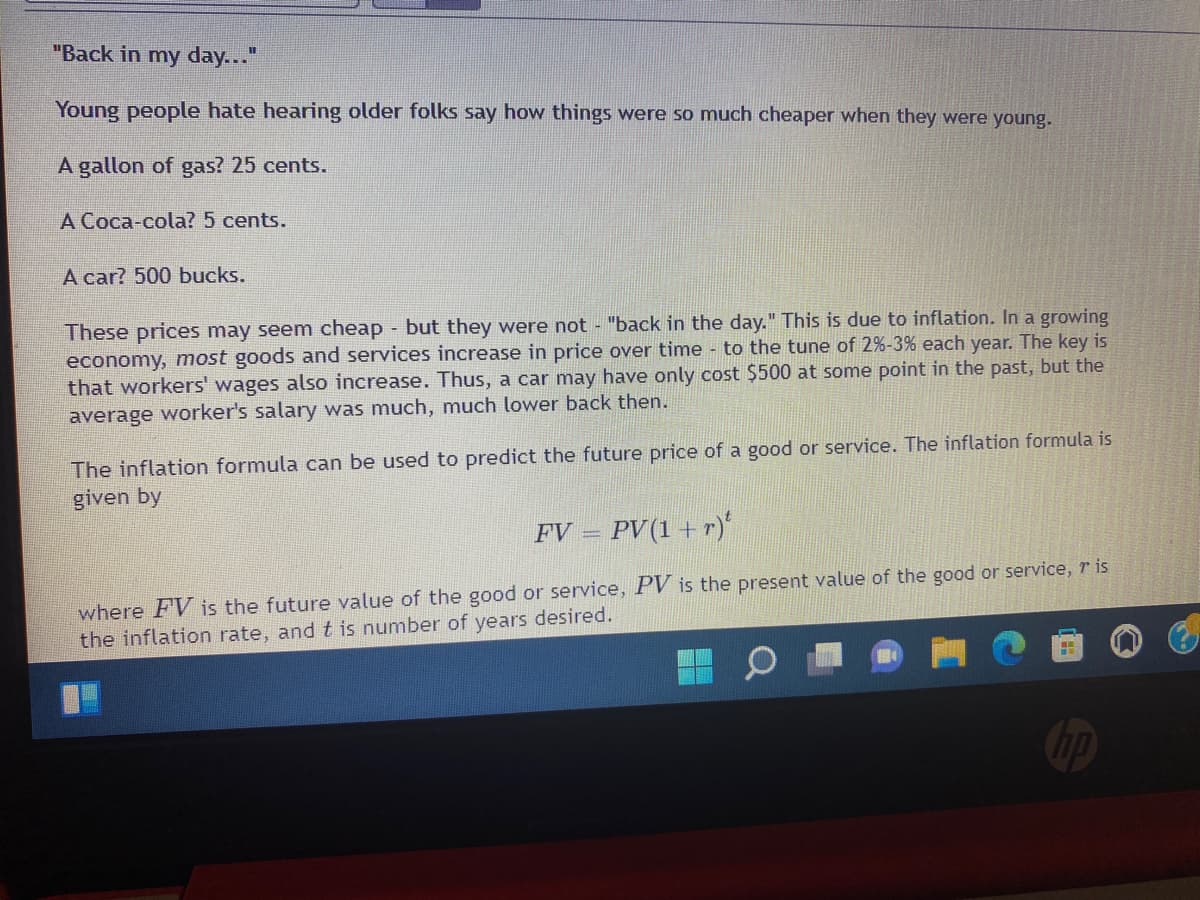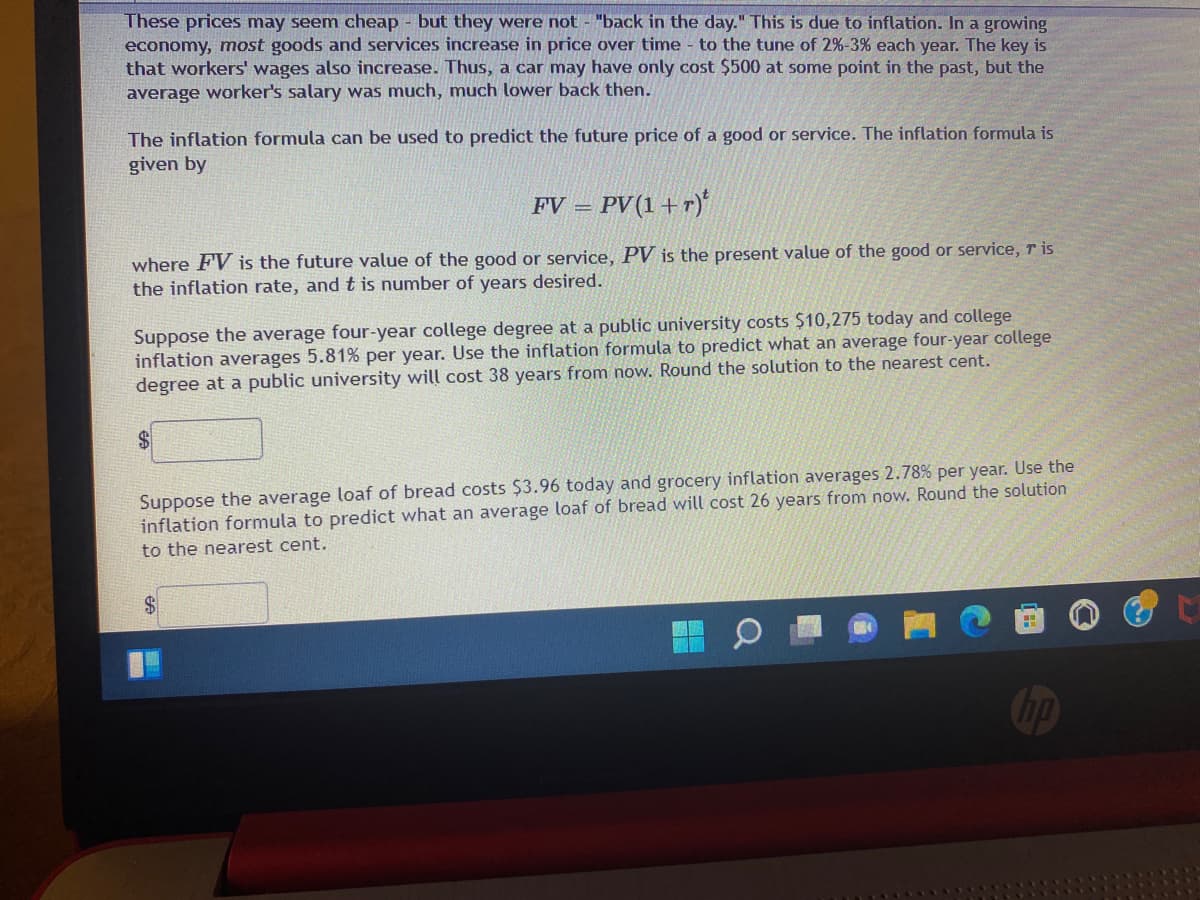These prices may seem cheap but they were not - "back in the day." This is due to inflation. In a growing economy, most goods and services increase in price over time - to the tune of 2%-3% each year. The key is that workers' wages also increase. Thus, a car may have only cost $500 at some point in the past, but the average worker's salary was much, much lower back then. The inflation formula can be used to predict the future price of a good or service. The inflation formula is given by FV = PV(1 +r)* where FV is the future value of the good or service, PV is the present value of the good or service, r is the inflation rate, and t is number of years desired. Suppose the average four-year college degree at a public university costs $10,275 today and college inflation averages 5.81% per year. Use the inflation formula to predict what an average four-year college degree at a public university will cost years from now. Round the solution to the nearest cent. $ Suppose the average loaf of bread costs $3.96 today and grocery inflation averages 2.78% per year. Use the inflation formula to predict what an average loaf of bread will cost 26 years from now. Round the solution to the nearest cent.
These prices may seem cheap but they were not - "back in the day." This is due to inflation. In a growing economy, most goods and services increase in price over time - to the tune of 2%-3% each year. The key is that workers' wages also increase. Thus, a car may have only cost $500 at some point in the past, but the average worker's salary was much, much lower back then. The inflation formula can be used to predict the future price of a good or service. The inflation formula is given by FV = PV(1 +r)* where FV is the future value of the good or service, PV is the present value of the good or service, r is the inflation rate, and t is number of years desired. Suppose the average four-year college degree at a public university costs $10,275 today and college inflation averages 5.81% per year. Use the inflation formula to predict what an average four-year college degree at a public university will cost years from now. Round the solution to the nearest cent. $ Suppose the average loaf of bread costs $3.96 today and grocery inflation averages 2.78% per year. Use the inflation formula to predict what an average loaf of bread will cost 26 years from now. Round the solution to the nearest cent.
Algebra and Trigonometry (6th Edition)
6th Edition
ISBN:9780134463216
Author:Robert F. Blitzer
Publisher:Robert F. Blitzer
ChapterP: Prerequisites: Fundamental Concepts Of Algebra
Section: Chapter Questions
Problem 1MCCP: In Exercises 1-25, simplify the given expression or perform the indicated operation (and simplify,...
Related questions
Question

Transcribed Image Text:"Back in my day..."
Young people hate hearing older folks say how things were so much cheaper when they were young.
A gallon of gas? 25 cents.
A Coca-cola? 5 cents.
A car? 500 bucks.
These prices may seem cheap - but they were not - "back in the day." This is due to inflation. In a growing
economy, most goods and services increase in price over time to the tune of 2%-3% each year. The key is
that workers' wages also increase. Thus, a car may have only cost $500 at some point in the past, but the
average worker's salary was much, much lower back then.
The inflation formula can be used to predict the future price of a good or service. The inflation formula is
given by
FV
PV (1 + r)
where FV is the future value of the good or service, PV is the present value of the good or service, r is
the inflation rate, andt is number of years desired.

Transcribed Image Text:These prices may seem cheap but they were not - "back in the day." This is due to inflation. In a growing
economy, most goods and services increase in price over time to the tune of 2%-3% each year. The key is
that workers' wages also increase. Thus, a car may have only cost $500 at some point in the past, but the
average worker's salary was much, much lower back then.
The inflation formula can be used to predict the future price of a good or service. The inflation formula is
given by
FV =
PV(1+r)*
where FV is the future value of the good or service, PV is the present value of the good or service, r is
the inflation rate, and t is number of years desired.
Suppose the average four-year college degree at a public university costs $10,275 today and college
inflation averages 5.81% per year. Use the inflation formula to predict what an average four-year college
degree at a public university will cost 38 years from now. Round the solution to the nearest cent.
$4
Suppose the average loaf of bread costs $3.96 today and grocery inflation averages 2.78% per year. Use the
inflation formula to predict what an average loaf of bread will cost 26 years from now. Round the solution
to the nearest cent.
Chp
Expert Solution
This question has been solved!
Explore an expertly crafted, step-by-step solution for a thorough understanding of key concepts.
Step by step
Solved in 3 steps with 3 images

Recommended textbooks for you

Algebra and Trigonometry (6th Edition)
Algebra
ISBN:
9780134463216
Author:
Robert F. Blitzer
Publisher:
PEARSON

Contemporary Abstract Algebra
Algebra
ISBN:
9781305657960
Author:
Joseph Gallian
Publisher:
Cengage Learning

Linear Algebra: A Modern Introduction
Algebra
ISBN:
9781285463247
Author:
David Poole
Publisher:
Cengage Learning

Algebra and Trigonometry (6th Edition)
Algebra
ISBN:
9780134463216
Author:
Robert F. Blitzer
Publisher:
PEARSON

Contemporary Abstract Algebra
Algebra
ISBN:
9781305657960
Author:
Joseph Gallian
Publisher:
Cengage Learning

Linear Algebra: A Modern Introduction
Algebra
ISBN:
9781285463247
Author:
David Poole
Publisher:
Cengage Learning

Algebra And Trigonometry (11th Edition)
Algebra
ISBN:
9780135163078
Author:
Michael Sullivan
Publisher:
PEARSON

Introduction to Linear Algebra, Fifth Edition
Algebra
ISBN:
9780980232776
Author:
Gilbert Strang
Publisher:
Wellesley-Cambridge Press

College Algebra (Collegiate Math)
Algebra
ISBN:
9780077836344
Author:
Julie Miller, Donna Gerken
Publisher:
McGraw-Hill Education